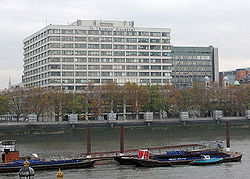Lambeth: Difference between revisions
Created page with '{{Infobox town |name=Lambeth |county=Surrey |picture=St.thomas.hospital.arp.750pix.jpg |picture caption=St Thomas' Hospital |os grid ref=TQ305785 |latitude=51.4903 |longitude=-0…' |
|||
| Line 32: | Line 32: | ||
==References== | ==References== | ||
{{reflist}} | {{reflist}} | ||
[[Category:Metropolitan Surrey]] | |||
Revision as of 11:11, 25 January 2016
| Lambeth | |
| Surrey | |
|---|---|
 St Thomas' Hospital | |
| Location | |
| Grid reference: | TQ305785 |
| Location: | 51°29’25"N, 0°7’9"W |
| Data | |
| Post town: | London |
| Postcode: | SE1, SE11 |
| Dialling code: | 020 |
| Local Government | |
| Council: | Lambeth |
| Parliamentary constituency: |
Vauxhall |
Lambeth is a Surrey town on the south bank of the River Thames long since deep within the metropolitan conurbation. Lambeth has a mixture of down-market, working class estates and wealthy streets given to commerce and residences. Some of the dynamics shaping the town are Waterloo Station, Westminster Bridge and other bridges upstream, and the riverside.
Lambeth Palace has been the main residence of the Archbishop of Canterbury since the Middle Ages. It stands close to the riverside opposite the Palace of Westminster. The two were linked by a horse ferry across the Thames until Westminster Bridge was built a little downstream.[1] A more recent civic building is County Hall on the banks of the Thames, glowering at the Palace of Westminster in its former role as headquarters of the former London County Council (for which it was built) and its successor, but now a hotel and the home of the London Aquarium.
Names of the town
The name of Lambeth is Old English: Lambhyþ meaning "lamb wharf": The name is recorded in a Latin charter of 1062 as Lambehitha and in 1255 as Lambeth.
"South Lambeth" is recorded as early as 1241 as Sutlamehethe and "North Lambeth" appears in 1319 as North Lamhuth. The marshland in the area, known as Lambeth Marshe, was drained in the 18th century but is remembered in the Lower Marsh street name. At some time after the opening of Waterloo railway station in 1848 the locality around the station and Lower Marsh became known as Waterloo.
History
Until the mid-18th Century the north of Lambeth was marshland, crossed by a number of roads raised against floods. With the opening of Westminster Bridge in 1750, followed by the Blackfriars Bridge and Vauxhall Bridge, a number of major thoroughfares were developed through Lambeth, such as Westminster Bridge Road, Kennington Road and Camberwell New Road.[1]
Literary Lambeth
In William Blake's epic Milton a Poem, the poet John Milton leaves Heaven and travels to Lambeth, in the form of a falling comet, and enters Blake's foot. This allows Blake to treat the ordinary world as perceived by the five senses as a sandal formed of "precious stones and gold" that he can now wear. Blake ties the sandal and, guided by Los, walks with it into the City of Art, inspired by the spirit of poetic creativity. The poem was written between 1804 and 1810.
A better known "Lambeth Walk" is the street of that name and more particularly the song of the name from the 1937 musical Me and My Girl, which celebrates Cockney culture and Lambeth's place in it.